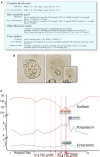Iso-osmolar hyponatremia from polyethylene glycol
- PMID: 33623696
- PMCID: PMC7886577
- DOI: 10.1093/ckj/sfaa087
Iso-osmolar hyponatremia from polyethylene glycol
Abstract
Understanding and applying pathophysiological concepts to patient care is an important skill for physicians in the clinical setting. Here, we present a case that demonstrates how the application of common physiological concepts relating to the widely accepted hyponatremia algorithm led to an accurate diagnosis of hyponatremia. This case documents iso-osmolar hyponatremia caused by orally administered polyethylene glycol absorption in the gastrointestinal tract. Herein, we discuss the workup and differential diagnosis for iso-osmolar hyponatremia in juxtaposition with the pathophysiological mechanisms unique to this case. We discuss these pathophysiological mechanisms based on the patients' laboratory data and responses to therapeutic interventions.
Keywords: hyperkalemia; hyponatremia; ileus; iso-osmolar; osmolality; polyethylene glycol; sarcoidosis.
© The Author(s) 2020. Published by Oxford University Press on behalf of ERA-EDTA.
Figures


References
-
- Buck KK. Clinical Review Polyethylene Glycol 3350 Over-the-Counter Application 2005 https://www.accessdata.fda.gov/drugsatfda_docs/nda/2006/022015s000_MedR_... (21 April 2020, date last accessed)
-
- Cox DP. The biodegradation of polyethylene glycols. Adv Appl Microbiol 1978; 23: 173–194 - PubMed
-
- American Gastroenterological Association, Bharucha AE, Dorn SD. et al. American Gastroenterological Association medical position statement on constipation. Gastroenterology 2013; 144: 211–217 - PubMed
-
- Lifton LJ. On the safety of “Golytely”. Gastroenterology 1984; 86: 214–216 - PubMed
-
- Eherer AJ, Fordtran JS.. Fecal osmotic gap and pH in experimental diarrhea of various causes. Gastroenterology 1992; 103: 545–551 - PubMed
Publication types
LinkOut - more resources
Full Text Sources

